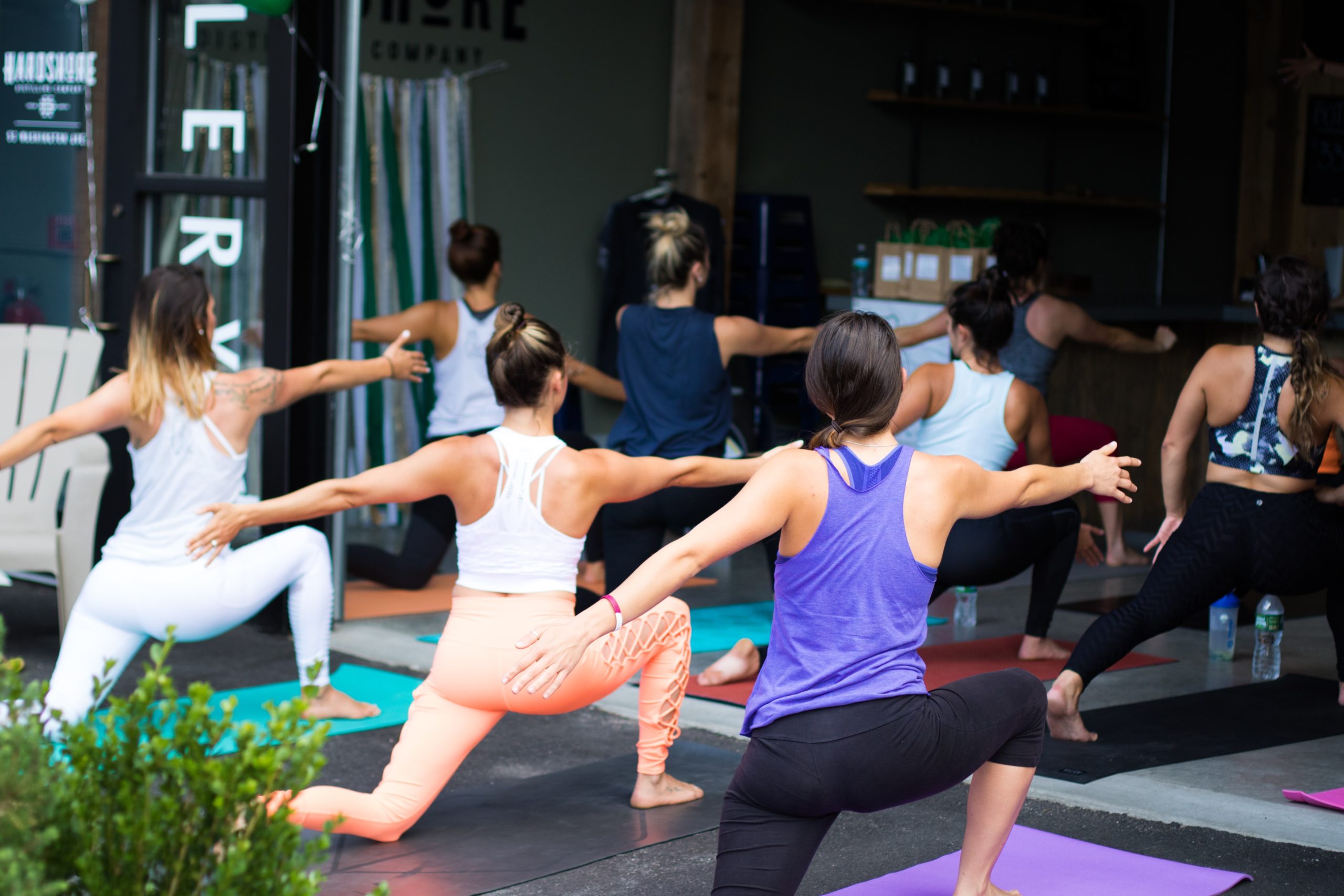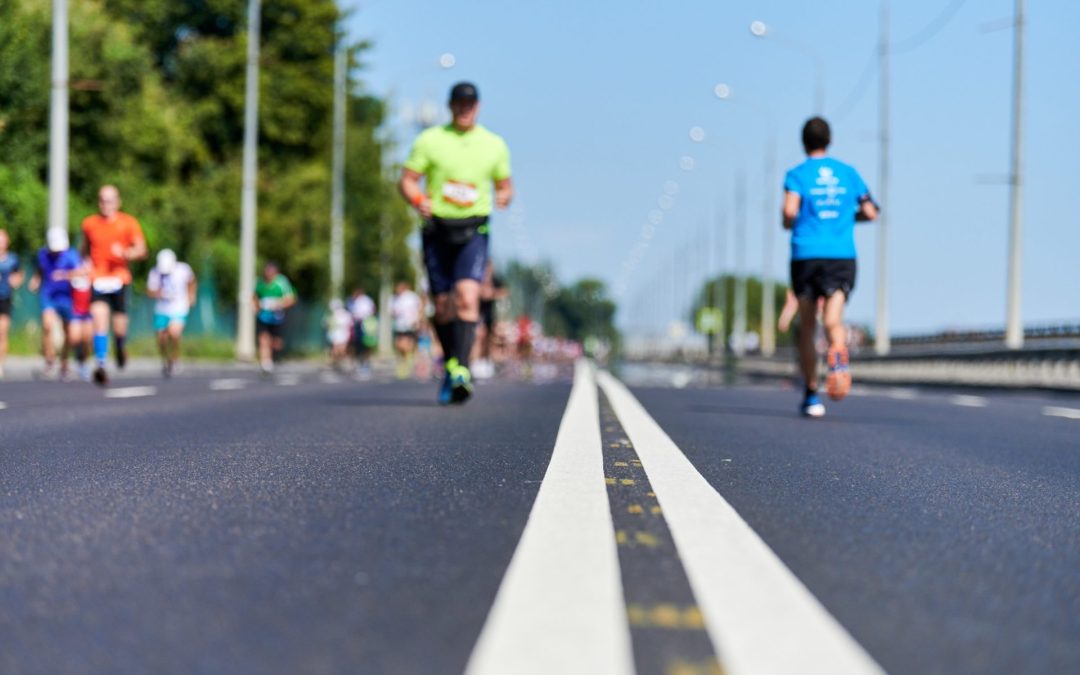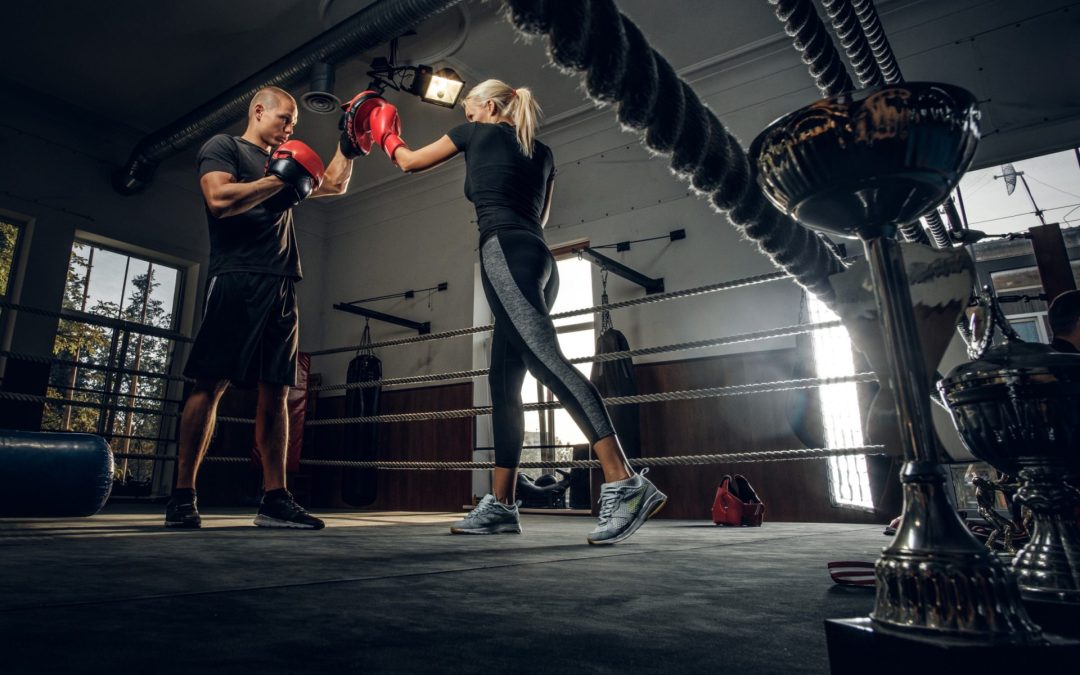It’s hard to find a wellness trend that has ever experienced more popularity than yoga. Yoga is an ancient and remarkable practice that finds its roots in India. It’s a fusion of meditation and different breathing techniques that help improve your overall health.
Yoga has been around for centuries and its benefits extend beyond just your physical health. It helps to improve strength, balance, and overall well-being. It also enhances your mental clarity. Knowing the history, types, benefits, and different yoga poses will help you take advantage of this ancient practice.
From the classic Sun Salutation to the challenging Crow Pose, there’s a wide range of yoga poses for enthusiasts of all levels.
So, whether you’re a beginner or a yogi enthusiast couple looking for yoga poses for 2, learning about the roots of yoga and various poses helps you understand how to reap its full benefits.
This article discusses everything you need to know about the rich history of yoga, the benefits of yoga, and some common poses you can practice every day.
What is Yoga?
The literal meaning of the word yoga finds its roots in the ancient Sanskrit language rooted in India.
Yoga comes from the Sanskrit word yuj, which means to unite or bind something. When we’re talking about yoga, we define it as a journey of self-discovery, a practice that connects your mind, body, and spirit. It’s a remarkable blend of physical and mental harmony that boosts your health and brings internal peace.
So, in a world full of noise and chaos, yoga serves as a sanctuary of peace and tranquility. It’s a gift you give yourself to slow down and live in the present moment.
There are several different styles and approaches to yoga, but the underlying techniques bring out the best health benefits to improve your well-being.
Yoga is an adventure you undertake to improve your well-being and connect with your soul. It’s an illuminating path that helps you embrace your entire being. It’s also one of the most famous exercise forms today that help you undergo a journey of self-care in this chaotic world.
History of Yoga
As human beings evolved, Yoga has evolved with us. Its original traces may be linked to India, but its roots still raise uncertainty due to the oral transmission of the practice. The original yoga writings were transcribed on palm leaves, which made it very easy for the transcript to lose its original essence.
Yoga can be traced back more than 5,000 years in India, where the Indus-Sarasvati civilization developed the spiritual practice. Rigveda, a sacred text composition written around 1500 BCE, has the earliest mention of yoga. The practice of yoga has evolved and changed a lot over time.
Over the years, yoga influenced many schools of thought on philosophy and spirituality. These include Jainism, Buddhism, and Hinduism. Yoga’s long history is divided into four main periods that evolved with time.
Most people view yoga as just a form of exercise. However, yoga is more of a spiritual tradition, so it’s important to explore the rich history of yoga and understand its philosophy.
The Philosophy Behind Yoga Practice
Yoga is a practice that emphasizes the interconnectedness of everything associated with you. It helps you unite your body, mind, and spirit through meditation, breathing techniques, and posture.
The ultimate goal of yoga philosophy is to achieve self-realization through practicing detachment from the world and keeping your mind peaceful. You can attain the sustained state of pure awareness called Moksha through this.
Like Buddhism, yoga philosophy believes that ignoring spirituality invites suffering and reconnects us to the wheel of samsara (cycle of rebirth). We can reconnect to our body in different ways in yoga, but the central teachings of yoga revolve around practicing spirituality, detaching your mind, and self-awareness.
The law of karma, in particular, serves as a central philosophy of yoga. These foundational views in yoga can confuse the world, making it essential to understand them before you include yoga in your daily routine. Yoga philosophy also includes the concept of spiritual energies and subtle bodies.
So, to understand the philosophy, we’ll examine yoga’s history. Yoga can be divided into four major periods that date back 5,000 years ago.
Pre Classical Yoga
Pre-classical yoga was the early development of yoga philosophy that began before the classical period. It’s estimated to have begun around 400-200 BCE, meaning it existed around 6500-2400 years ago.
The pre-classical yoga spans from the Shamanic era to the beginning of classical yoga. The earliest known yoga reference in this era was in the Indus-Sarasvati civilization.
There is little information available on pre-classical yoga because most of it was transmitted orally or recorded in ancient texts. Some early references can be seen in the Vedas, a collection of Hindu scriptures from around 1500-2000 BCE old.
The Vedas contained mantras, songs, and rituals used by the Brahmans, the Vedic priests. They also include some of the most ancient Indian scriptures. It has over 20,000 verses that form practical guidelines for reaching a magical experience.
Pre-classical yoga had a critical figure, Patanjali, who is believed to have lived between the 2nd century and 5th century BCE. The yoga sutras are foundational texts that are attributed to Patanjali. They describe an eight-limbed path that includes ethical guidelines, breath control, meditation, etc.
Other important texts during the pre-classical phase include the Hatha Yoga Pradipka, Upanishads, and the Bhagavad Gita.
Classical Yoga
The classical yoga period was 2100-1500 years ago. Patanjali’s yoga sutras define the classical period as the first streamlined form of yoga. The sutras in this period are divided into four chapters discussing yoga’s power and how it helps liberate your soul, mind, and body.
The Yoga Sutras of Patanjali are considered the most authoritative and well-preserved yoga scripture. The Yoga Sutras cover the main points on how the concentration of the mind matters, the causes of suffering, and the eight-limbed path of Ashtanga yoga.
The eight-limbed path of Ashtanga yoga contains the steps towards obtaining Samadhi, or enlightenment. The virtues in Ashtanga Yoga include:
- Yama – ethical principles and moral codes
- Niyama – self-discipline and spiritual observances
- Asana – physical postures
- Pranayama – breath control
- Pratyahara – withdrawal of the senses
- Dharana – concentration
- Dhyana – meditation
- Samadhi – state of profound inner peace and self-realization
Patnajali’s Yoga Sutras continue to influence most modern yoga styles that emphasize the importance of self-discipline, concentration, and meditation. All these have to be attained to reach a state of ultimate enlightenment and purify the mind and body.
Post-classical Yoga
The post-classical yoga period is categorized from 1500-700 years ago. This period focuses on asana. The post-classical period rejected the ancient teaching of Vedas and embraced the physical body as a way to attain enlightenment.
Moreover, Tantra yoga was developed during this time to cleanse the body, mind, and soul and to break the knot that tied us to our physical existence. This led to the creation of Hatha Yoga.
Ashtanga Yoga and Bikram Yoga are also notable post-classical yoga systems. Ashtanga Yoga emphasizes a dynamic and physically demanding practice, while Bikram Yoga involves a fixed series of 26 postures and is practiced in a heated room.
Modern Yoga
Modern yoga came into existence only 300 years ago. A diverse range of yoga practices emerged in the 20th and 21st centuries, especially in the West. Modern yoga poses blend traditional practices with contemporary health and fitness trends.
Apart from Hatha yoga, other popular yoga styles include Yin yoga, which emphasizes holding passive stretches for longer periods, and Vinyasa yoga, which involves synchronizing your breath with movement.
Benefits of Practicing Yoga
Imagine standing at the edge of a serene lake or someplace that brings you peace. You take in a deep breath and exhale, feeling calm and relaxed. You connect with your mind, body, and soul as you step on your yoga mat. That’s just how one of the many benefits of yoga can help you.
If you’ve practiced hard yoga poses like the puppy, bow, lizard, scorpion, or the famous downward dog pose, you know how challenging and rewarding these can be.
Yoga has been passed down for generations. It’s more than just physical exercise; it incorporates breathing techniques, meditation, and mindfulness to promote well-being and holistic health. The benefits of yoga go beyond just improving physical health. It helps regulate sleep, improve pain relief, immune function, and more.
We’ll be diving into yoga’s remarkable benefits and how each pose brings you more peace.
Better Body Structure
Yoga helps you achieve inner awareness. It helps you shift focus on your body’s abilities and how you can develop the strength of your mind and body.
Yoga asanas focus on stretching and holding different body positions. These moves help build muscle strength and flexibility in your body. Yoga surveys have found that people who practice yoga regularly are more self-aware of their bodies and less self-conscious.
Thus, yoga has become a popular treatment that promotes healthy body images and raises self-esteem.
Building strength helps to perform daily activities and lowers procrastination rates. Most yoga poses require engaging your core, upper body, and lower body muscles.
Poses like the bird of paradise or eagle require a lot of muscle strength, which helps improve your overall strength.
Improved Balance
Yoga engages multiple muscle groups such as the legs, hips, and core. Engaging the core muscles helps to activate the body’s natural stabilizers and improve balance.
For instance, in the tree pose, you have to balance on one foot and lift the other. The lifted leg activates the hip muscles, which enhances your balance.
Yoga also helps improve proprioception, which is the body’s sense of where it is in space. Yoga poses require you to maintain alignment and adjust your center of gravity, ultimately improving spatial awareness.
Eases Arthritis Symptoms
Arthritis is a condition that affects the joints and causes reduced mobility, increased pain, and stiffness. Yoga helps to minimize these symptoms by strengthening your joints and improving the functionality your entire body.
Practicing gentle yoga poses and movements that focus on strengthening the joints is very beneficial, and this is accomplished in most all yoga poses and positions.
Yoga helps to promote blood circulation and overall physical function and reduces stress, which can be very useful for people with arthritis.
Enhances Cardiovascular Health
Small studies have shown a strong connection between yoga on cardiovascular risk factors. Slow yoga movements like Vinyasa or power yoga help lower blood pressure in people with hypertension.
Yoga also restores baroreceptor sensitivity, which helps the body’s senses to maintain balance.
Boosts Weight Loss and Maintenance
Yoga helps to improve your mindfulness which helps to reduce mindless eating. It also helps decrease your stress levels and keep you more relaxed and level-headed, which positively impacts weight loss.
Specific yoga poses also help reduce bloating and improve digestion, contributing to weight loss.
Types of Yoga
Whether you’re looking for a demanding or relaxing yoga routine, there are plenty of yoga styles you can try out. Each yoga pose is different, and variations would also differ from teacher to teacher. However, there are a few very common types.
Hatha Yoga
Hatha is a Sanskrit term that encompasses all physical postures (asanas) in yoga. Hatha is the most popular form of yoga because it involves physical activity and has numerous styles. So, if you’re new to yoga, Hatha classes are a great starting point.
Ashtanga Yoga
Asthanga is a physically demanding form of yoga. It consists of around 75 postures to be practiced in a specific order. This yoga practice helps to build strength, flexibility, and stamina and cleanses the body and mind.
Bikram Yoga
Bikram yoga poses are a popular style of yoga for those seeking a challenging and intense yoga form.
The yoga poses have to be practiced in a heated room and involve a series of 26 postures. The temperature in a Bikram yoga class is typically set at around 105 degrees Fahrenheit, with a humidity level of 40 percent. If you don’t enjoy saunas, then Bikram yoga is probabaly not for you.
Iyengar Yoga
Iyengar yoga is the perfect type for you if you’re looking to use controlled movement with precise alignment. Iyengar yoga is taught slowly and places importance on proper form and positioning.
In a typical Iyengar yoga class, you may have to use props such as blocks, straps, blankets, and chairs to help support your postures.
Kundalini Yoga
Kundalini yoga is a form that emphasizes the importance of the “kundalini” energy, which is believed to be coiled to your spine’s base. During this yoga, you must perform a series of postures with rapid breathing and chanting mantras.
This yoga helps stimulate the nervous system and promote a sense of inner peace and well-being.
Vinyasa Yoga
Vinyasa yoga emphasizes the connection between breath and movement. During this yoga type, you must synchronize your breath with a series of flowing movements (vinyasas).
These movements help relax your mind and promote a sense of inner peace. Vinyasa yoga always has unique poses as there is no set sequence of postures, making Vinyasa yoga a dynamic and energizing style of yoga.
Yin Yoga
Yin yoga is a relaxed and gentle type of yoga that involves holding long poses for an increased time. This helps stretch and strengthen the body’s deep connective tissues, including the fascia, ligaments, and joints.
Power Flow Yoga
Some people refer to power flow yoga as power vinyasa yoga, and this because it focuses heavily on the overall movements and “flow” of the poses. It is a very high energy form of yoga, and is great if you are trying to burn some extra calories. While many types of yoga focus on breathing and flexibility, power flow yoga focuses on strength, and it does this mainly by putting you in various poses that require and build it.
Different Poses You Can Do in Yoga
Practicing yoga doesn’t mean you must be a yoga enthusiast or an expert. Yoga can calm the mind and strengthen your body no matter how old you are. Yoga has many poses (asanas), but we’ll discuss some common poses.
Bow Pose
Bow pose, or the Dhanurasana, is a backbend pose that involves lying on your stomach and lifting your arms and legs while taking deep breaths to create a bow shape.
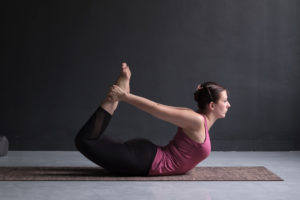
Bird of Paradise Yoga
The Svarga Dvijasana is an advanced yoga pose that involves standing on one leg only. You have to bind your other leg and extend the other leg out to the side.
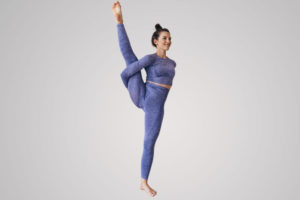
Lizard Pose
The lizard pose helps you to open up your hips. To practice this pose, you must bring one foot forward and place it on the ground while keeping the back leg straight. The pose is known as the Utthan Pristhasana in Sanskrit.
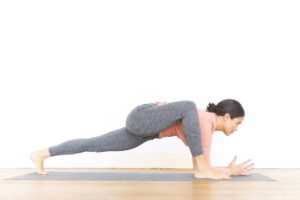
Scorpion Pose
The Vrischikasana is an advanced pose in which you have to kick up in a handstand and bend your legs back towards the head.
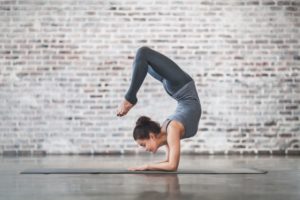
Eagle Pose
The Eagle pose or the Garudasana is a balancing pose. It helps improve balance by crossing one leg over the other and wrapping the arms around each other.
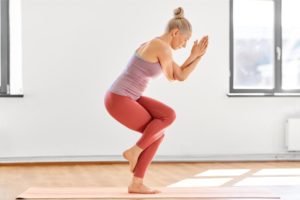
Puppy Pose Yoga
If you’ve tried the downward-facing dog, this pose will be easy. The Uttana Shishosana is a variation of the downward-facing dog. You must extend your arms forward and rest your forehead on the ground.
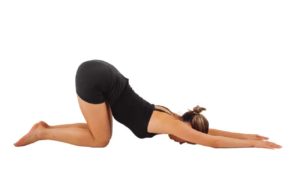
Goddess Pose
The Goddess pose (Utkata Konasana) involves squatting down while keeping the back straight and arms extending to the sides.
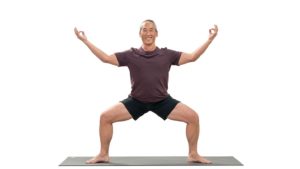
Standing Pose
The standing pose is a classic yoga pose where you have to stand on both feet and includes a variety of forward folds, back ends, and twists. There are many different variations of standing yoga poses, so for the example below we have chosen the crescent lunge (ashta chandrasana).
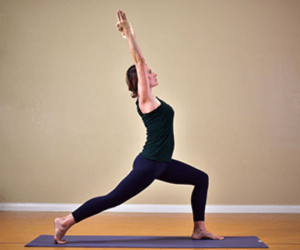
Half-moon Pose
Lastly, we have the Ardha Chandrasana or the Half-moon pose. This pose helps to improve balance by placing one hand on the ground with the opposite arm and leg extended upwards to the ceiling.
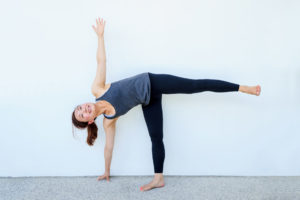
How Can You Get Started With Yoga?
Getting started with something new may seem like a lot of work, and change can be challenging. Yoga is an art of self-discovery that lets you unwind your inner self and connect with yourself.
So, to embark on this journey, you’ll need an open mind, a willing spirit, and a few tools to help you get started.
Start Enthusiastically
Learn to appreciate your body no matter how it looks. Yoga means union in all aspects of your life, so there’s no room for separation between your thoughts and present state. Hence, it’s important to think positively and start your yoga journey with an open mind.
Let Go of Expectations
Building expectations is normal human nature, but it could be useful when beginning yoga. Imagining “my back should be completely flexible by now” shouldn’t cross your mind. Try to get into the right mindset and let yoga evolve naturally through your body and mind.
Start With Beginner Classes
Beginner classes help you explore your body and mind and appreciate it. You don’t have to start with hard yoga poses right away. Learning the basics help build a strong foundation. Also, don’t ever be shy to look around the yoga class and learn by watching the more experienced people.
Regular Practice
Like anything else, yoga requires time and patience. Consistency is key when it comes to implementing yoga in your life. Try incorporating a few poses daily, even for only a few minutes. If muscle memory ever paid off big time, it’s for Yoga.
Listen to Your Body
Trying to go overboard with yoga practices or pushing yourself too much shouldn’t be on your list. Listen to your body during each pose and make alterations if you experience any discomfort or pain.
What Should You Know Before Your First Class?
Yoga is so much more than just breathing and stretching. Here are a few things you should know if you join a yoga class.
Arrive Early
If you’re joining a new class, arriving early and familiarizing yourself with the space is a good idea. It’ll help you get settled, introduce yourself to the teacher, set up your things, and talk to other students.
Wear Comfortable Clothes
Please wear clothes that won’t limit our movement and will be comfortable. You can find specific clothes made for yoga as well.
You Might Not Be Able To Do All the Poses
Even in a beginner’s class, some poses can be challenging. Your body will take time to adjust to this new routine. It’s normal to have less flexibility and struggle with hard yoga poses. The important thing is to stay consistent and not give up.
Deep Breaths
Yoga is all about connecting your body and your breath. Make sure to breathe deeply throughout the class and allow your breath to guide you through each pose.
How Often Should You Do Yoga?
Yoga, like any other exercise, requires consistency.
Including yoga in your routine two to five times per week is good at the beginning. You can increase your yoga session over time depending on your personal goals, schedule, and physical abilities.
If you’re beginning with yoga, you can start practicing it once or twice weekly to build your pace and avoid injury.
Myths About Yoga
If you think you have to be flexible for yoga, think again. Yoga is for everybody, but misconceptions about yoga are common. So, we’ll debunk some myths about yoga that you should stop believing.
You Have To Be Flexible To Do Yoga
Yoga is a practice that helps you build flexibility over time. So, if you think only naturally flexible people can go for yoga, you’re wrong.
Yoga Is a Religious Practice
Yoga does have deep connections to spirituality and religions like Hinduism and Buddhism, but that doesn’t mean it’s a religious practice.
It can be adapted to fit any spiritual belief system or practiced as a physical or mental exercise.
Yoga Is Easy and Not a Workout
Yoga may be gentle and relaxing, but many hard poses require you to engage your full core. It can also be a great way to improve your health, increase flexibility, and improve cardiovascular health. What happens more times than people realize, is very in-shape and fit men and women go to take a yoga class for the first time and struggle since it really is something completely unique that requires practice.
Takeaway: Find Balance and Vitality Through Yoga
Yoga has been around for thousands of years and has a rich history. It has been shown to have countless health benefits and also helps improve your mental clarity.
It’s a great practice to reduce stress, strengthen your core, and promote overall well-being.
We’ve discussed the different types and poses you can incorporate into your routine and how yoga serves as a valuable tool in achieving a healthier, happier, and more balanced life.
Yoga is also a great thing to master because you can do it on vacation and wherever you go. For more ways on how to stay healthy while on vacation, check out this article.
Zoppler is reader supported and may earn affiliate commissions from links on this page. We support and believe in all the products and services we promote and are affiliated with.

